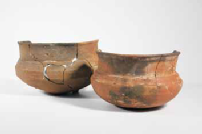
We research, care for and share the archives of the parish of Barton Stacey, Hampshire.


Pit grave, Barton Stacey
Extract from The Southern Feeder: The Archaeology of a Gas Pipeline
ISBN 0 903545 32 2, Published by The British Gas Corporation 1984.
The Southern Feeder gas pipeline runs for 220 miles from Wisbech, Cambridgeshire, to Barton Stacey in Hampshire. This is a record of the various archaeological artefacts and discoveries made during its construction.
Page 85
Site BS/M 2 (Map 11)
NGC [National Grid Company] trenching operations were followed on either side of the settlement. Lynchets and soil disturbances were observed to the SW, commencing 150m from the enclosure ditch.
In Barton Stacey, the machine cut neatly through the centre of a pit grave, leaving the upper half of a human cranium in the NW face of the trench, and the ankle and foot bones in the SE face. The remainder of the skeleton was flung on the spoil heap, from which some long bones were recovered. A bone pin, 100mm long, was seen lying in situ beside the cranium but was lost in the interval between the discovery and the arrival of local police.
The rectangular grave pit was is two parts, the upper one metre deep and a narrow section 300mm deeper, cut so as to leave 100mm shelf on either side. The body had been laid flat in the lower section and may have been protected by horizontal planking which rested on the shelves.
Early Iron Age Metalworking and Iron Age/ Early
Romano-British Settlement Evidence along the
Barton Stacey to Lockerley Gas Pipeline
Finds and Environmental Reports
To accompany publication text in Hampshire Studies 68, 2013. By Robert De'Athe. Wessex Archaeology.
The BARTON STACEY POTTERY FINDS.
These were tripartite bowls and jars with a hammerhead rim.
The bowls are ‘scratched-cordoned bowls’, examples of which are found on many other sites in the region. One of the bowls from Barton Stacey was found in pit 28039, along with two hammerhead jars, a type dated to the 7th–5th centuries BC. The Barton Stacey examples have upright necks and beaded rims, faceted shoulders emphasised by cordons, and the shoulders are red-finished (haematite-coated). At Danebury this form relates to ceramic phase 3, dated 470–360 BC. At Barton Stacey, however, a significantly earlier date can be attached to at least one of the bowls which was recovered from the lowest fill of pit 28039; a radiocarbon date of 790–530 BC was obtained from one of the overlying fills. This would place it within the Earliest Iron Age ceramic phase.
Sandy wares dominate the pottery, and it seems likely that much of the Barton Stacey Early Iron Age pottery was locally made. However, the hammerhead jars was not locally available and these vessels were probably bought to the site from elsewhere as finished products, rather than the clay or temper being brought in. The strong similarity between these vessels and the examples from Danebury, in both fabric and form, hint at a single production source for this type of jar, suggestive of regional trading patterns rather than on-site or local manufacture for these vessels.
Early Iron Age
Scratched-Cordoned Bowl from pit 28049, similar to the bowls found in Barton Stacey.

Details of all historic sites in Hampshire are available in the Hampshire Environment Records (HER) posted on Hantsweb.
https://maps.hants.gov.uk/historicenvironment/
The section on How to Use the maps is clear and explains how to link, for each site, to a brief description of what archaeology was found and the opportunity to read a more detailed account.